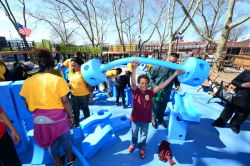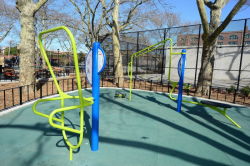Betsy Head Park
Betsy Head Play Center
This text is part of Parks’ Historical Signs Project and can be found posted within the park.
Given official landmark status in 2008 by the NYC Landmarks Preservation Commission, the Betsy Head Play Center is a model public recreation building and represents a golden era of construction for New York parks. Financed by the Works Progress Administration, the pool and recreation center is one of 11 such facilities that opened in 1936 under mayor La Guardia and Parks Commissioner Robert Moses, designed to accommodate 5,500 swimmers. The landmark within Betsy Head Park consists of the bathhouse, swimming pool, bleachers, filter house, and perimeter cast iron fencing.
Projects undertaken during the WPA-era are widely considered to be among the most remarkable public recreation buildings in the country, and Betsy Head Play Center is a particularly shining example with its efficient design, attractive layout, and creative use of cheap construction materials. Designed by John Matthew Hatton, Betsy Head Pool is noteworthy for its simplified yet sleek geometric and curvilinear forms, attributes of the era’s prevailing Arte Moderne and Modern Classical styles. Design experts cite its extensive use of recessed glass-block walls and the rooftop observation gallery with a canopy supported by eight parabolic arches as the building’s highlights. Other design features include a brick pier in the lobby which extends to the roof where it is clad in glass block (which used to function as a light source for evening activities), and vents above the shower rooms that were used as light shafts. (Talk about energy efficiency!)
While the builders achieved this cutting edge design through the WPA-mandated use of cheaper materials such as brick and cast concrete, the main entrance features relatively lavish materials, including polished black marble wall facings, curved corner sections of glass block, and slate paving. The center went through a major rehabilitation in the early 1980s. The olympic-size pool is still in use, and the diving pool is now filled in with sand and used as a volleyball court.
Projects undertaken during the WPA-era are widely considered to be among the most remarkable public recreation buildings in the country, and Betsy Head Play Center is a particularly shining example with its efficient design, attractive layout, and creative use of cheap construction materials. Designed by John Matthew Hatton, Betsy Head Pool is noteworthy for its simplified yet sleek geometric and curvilinear forms, attributes of the era’s prevailing Arte Moderne and Modern Classical styles. Design experts cite its extensive use of recessed glass-block walls and the rooftop observation gallery with a canopy supported by eight parabolic arches as the building’s highlights. Other design features include a brick pier in the lobby which extends to the roof where it is clad in glass block (which used to function as a light source for evening activities), and vents above the shower rooms that were used as light shafts. (Talk about energy efficiency!)
While the builders achieved this cutting edge design through the WPA-mandated use of cheaper materials such as brick and cast concrete, the main entrance features relatively lavish materials, including polished black marble wall facings, curved corner sections of glass block, and slate paving. The center went through a major rehabilitation in the early 1980s. The olympic-size pool is still in use, and the diving pool is now filled in with sand and used as a volleyball court.
Check out your park's Vital Signs
Clean & Safe
$27.8M
Recent Investment
Green & Resilient
89
Mapped Trees
No natural areas present at this site.
Empowered & Engaged Users
No active volunteer groups.
Share your feedback or learn more about how this park is part of a
Vital Park System









